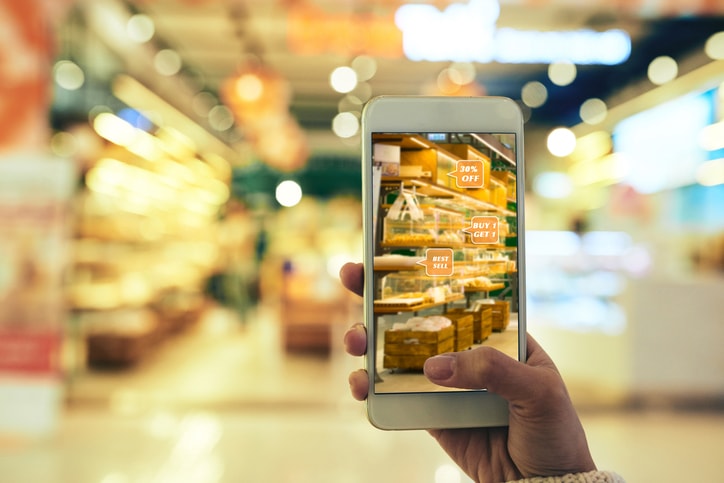By Amanda Bowman
Augmented Reality (AR) is 2018’s major marketing buzzword.
If you’re not familiar with augmented reality, AR is, according to Wikipedia:
a live direct or indirect view of a physical, real-world environment whose elements are “augmented” by computer-generated perceptual information, ideally across multiple sensory modalities, including visual, auditory, haptic, somatosensory, and olfactory.[1] The overlaid sensory information can be constructive (i.e. additive to the natural environment) or destructive (i.e. masking of the natural environment) and is spatial registered with the physical world such that it is perceived as an immersive aspect of the real environment.[2] In this way, Augmented reality alters one’s current perception of a real world environment, whereas virtual reality replaces the real world environment with a simulated one.[3][4]
AR is more than a buzzword.
AR is an exciting and engaging way for marketers to get in touch with customers.
According to a report from Digi-Capital, AR technology is poised to become part of the mainstream significantly faster than previously anticipated. It is projected, for example, that the market for mobile AR will be worth an incredible $108 billion by 2021.
Global Market Insights predicts that the AR market is expected to nearly double in size by 2024. GMI notes:
As our mobile devices become more powerful and social apps better integrate with AR, brands will use AR to better engage with consumers. For example, using your location, brands could trigger sponsored AR content, which can only be accessed at that spot, at that time. Pokémon Go was the pioneer with this idea, and I feel Instagram and Facebook will soon be integrating this tech into its platforms. – Chris Carter, Rep Interactive
Brands want to engage more meaningfully with their customers, and AR technology offers an ideal platform to achieve that heightened level of engagement on social media and elsewhere.
According to a Deloitte survey, nearly 90 percent of companies with revenues between $100 million and $1 billion are already using some form of AR (or virtual reality) as part of their business.
The ubiquity of smartphones in combination with now widely available AR developer kits makes it easier than ever for companies to close the distance between digital and physical consumer interactions.
Even small businesses and startups should consider this chance to connect their product to the lives of their customers. Companies can combine packaging design, printed materials, artificial intelligence, and augmented reality to create a genuinely engaging digital experience.
Over the years, we’ve seen more and more companies offering AR services to others. For example, we helped Holition, a creative innovation studio that among other things, leverages AR, with a logo design and business card design project. Today, Holition works with some of the world’s most exclusive brands (De Beers, TAGHeuer, Louis Vuitton, Lacoste, and many more).
Keep in mind that AR isn’t just about adding something to the real world that’s not already there. It can also mean subtracting something from a person’s view to declutter.
For example, if your company make gluten-free products, an AR app can let the customer look at retail shelves and see just gluten-free products available for purchase (removing the noise of all other products on the shelves).
We looked at the creative ways companies are using AR in their marketing to give you some ideas on how you can incorporate AR in your own marketing strategy.
Will it fit?
What has over 200 million published copies worldwide and is almost as popular as the Bible and the Harry Potter series?
If you said “the catalog from that Swedish furniture company with the meatballs,” you’d be right!
IKEA was one of the first to adopt augmented reality when the company added it into the app version of its ubiquitous catalog way back in 2014.
As innovative as it was, that version was still quite limited. It required a copy of the paper catalog present, and the interface was tiny and hard to use.
In 2017 Apple released iOS 11, which included ARKit. ARKit is the tech giant’s framework that created the possibility for any developer to add augmented reality to their apps quickly. Ikea quickly took advantage of this and released their newest kick at the AR can: IKEA Place.
“The first [augmented reality] experience we had was more like a picture,” said Michael Valdsgaard, Ikea’s head of digital transformation to Wired. “You could put in a 3-D object, but you couldn’t really move around it or trust the size of it.”
Apple’s ARKit changed all of this. As Wired reported:
Now, Ikea claims the 3-D furniture in Ikea Place shows up at scale with 98 percent accuracy, with true-to-life representations of the texture, fabric, lighting, and shadows. In testing the app, that held up: Digital sofas and chairs sprang to life realistically next to permanent, physical objects.
Ikea’s new app is an excellent example of how companies can use augmented reality to create a delightful and useful experience for customers.
The ability to see a product —normally tied to a showroom — in your own home helps customers figure out “will it fit?” and “will it work?” in a free and fun way.
Will it look good?
One of the most significant benefits of augmented reality is it is truly immersive marketing.
Customers can use the technology to pull items digitally into their world; a feature Ikea used to good effect with their Ikea Place app.
Apple has pushed AR heavily as a key feature of iOS 11 and their latest phones. CEO Tim Cook has made a point of touting the company’s vision where it believes augmented reality could go.
“I think AR is big and profound,” Cook said during a recent earnings phone call. “This is one of those huge things that we’ll look back at and marvel at the start of it. I think customers are going to see it in a variety of ways and it feels great to get [AR] going at a level that can get all of the developers behind it.”
Updates to iOS 11 have continued to build on the initial promise of ARKit.
iOS 11.3 (currently in public beta) gives developers the ability to project scenes onto flat, vertical surfaces. It’s easy to see companies that sell wall-based products like art, wallpaper, and paint using this feature so customers can preview a product before buying.
Companies like Augment are building on this idea with services that integrate AR to project product previews in real-time.
Online shopping giant Amazon is also using AR to give customers this “preview-in-place” ability. Customers in the United States can use the Amazon app on their iOS 11 devices to place “thousands of items” virtually into their homes.
Other retailers like Wayfair and Target have also integrated AR into their digital catalogs.
Target’s implementation is interesting because it’s not app-based; it runs on the target.com mobile site. They call this feature “See It In Your Space”:
Guests shopping the new Project 62 line can use the feature to place three-dimensional versions of real Target home products within photos of actual rooms at home and move them around at proper scale to see how they’d look—all before buying the product.
art.com has added AR to their iPhone app as well. ArtView gives customers the ability to preview art and other wall-mounted products. TechCrunch looked at the new feature and came away impressed:
The company’s ArtView feature is one of the few augmented reality features that adds a lot to the app it’s put in. With the ARKit-enabled tech, the artwork is accurately sized, so you can get a perfect idea of how your next purchase could fit on your wall. The feature can be used for the two million pieces of art on the site and can be customized with different framing types.
Beauty product companies have used relatively crude augmented reality “mirrors” for years but advances in AR have created new opportunities to refine and improve on the concept. Sephora paved the way when it released “Sephora Virtual Artist” as part of its iOS app.
The app creates a scan of your face and then lets you play around with lip colors, eyebrows, and eyelashes. It also has video tutorials that use your face to demonstrate makeup application techniques.
The virtual artist feature was created in partnership with Modiface, an augmented reality technology firm. Modiface has also partnered with other beauty brands like MAC and Estée Lauder.
And let’s not forget the millions of people using Android devices.
Customers using Android phones and tablets will get a chance to use tools like this now that Google has also rolled ARCore, its own AR developer kit.
While it’s still too early to know how useful adding AR to the shopping experience will be, the potential is there.
Will it show me more?
One of the most promising applications of augmented reality is how it can be used to bring information and new experiences to people in surprising and engaging ways.
Augmented reality can turn a static image or object into something full of movement and wonder.
Many companies are using this to bring new life (almost literally) to existing marketing campaigns, or launch unique experiences purely based on AR.
An early example of this technique is movie theatre chain AMC’s use of AR to extend movie posters. Customers pointed their phones at posters while running the AMC app to see cast info, trailers, and other information.
Another use of augmented reality and movie marketing can be found at Universal Studios Orlando.
The park uses AR to bring the dinosaurs from the Jurassic Park 2 movie franchise to life. When a visitor stands on a Hollywood star, they can see themselves become surrounded by dinosaurs, who menacingly move around them.
Monsters becoming part of real life was arguably the turning point for augmented reality as a mainstream technology when Pokemon Go landed in 2016.
While the numbers are still a bit of a mystery (as Apple doesn’t release app store install statistics), it’s safe to say that many millions of people tried to “catch them all.”
Third party estimates put the number of weekly downloads during the peak Pokemon craze at 20 to 30 million just in the US alone, with 26 million active users.
Pepsi Max gave Londoners an experience to remember when they took over a bus stop to add some unbelievable moments via AR.
A cleverly equipped bus shelter mixed what was happening outside of it with some wild moments like prowling tigers, giant tentacles bursting through the sidewalk, and flying saucers.
The campaign was a huge success, boosting sales of Pepsi Max by 30 percent.
Videos captured of people’s reactions to the stunt brought more than 6.9 million views to Pepsi Max’s YouTube channel and was widely shared across social media.
Museums and art galleries are natural adopters of augmented reality, like the Detroit Institute of the Arts demonstrated with their show called Lumin. DIA director Salvador Salort-Pons told the Detroit Free Press:
This technology brings works of art to life. It encourages visitors to look at works of art in the flesh.
Take, for instance, a panel of Mesopotamian reliefs that are gray to the naked eye: When viewed through Lumin, they’re filled with rich, vivid colors. “You can see that they once were painted in the past,” continued Salort-Pons. “It’s difficult to visualize that. The learning experience is immediate.”
The educational opportunities that augmented reality present have not been missed by news organizations, either. News site Quartz integrated augmented reality into its iPhone app to provide readers with a closer look at newsworthy objects.
For example, coverage of the Cassini spacecraft that ended its mission by plunging into Saturn’s atmosphere came with an AR model of the spacecraft. Readers could use the AR model to example the Cassini craft as if it were in the room with them.
Even though it’s been around for a while, new technologies and advancements mean that augmented reality is just getting started. It’s not difficult to see how the technology could bring a lot of value to products and marketing campaigns.
Augmented reality can improve your customer’s in-store experience by providing them with information or a product demo simply with a glance at their phone. It can make your products easier to understand through AR-based tutorials or provide delight through surprise bonus content.
Today, many large companies are experimenting with AR.
But this doesn’t mean that small business owners and entrepreneurs should ignore AR. With heightened customer expectations and the opportunity to enhance the customer experience, companies of all sizes need to understand how they could leverage AR in their businesses.
If you are ready to create a quality mobile app for your business that capitalizes on the AR trend, consider enlisting the help of crowdspring’s network of 210,000 creatives to give you great options. Crowdspring’s mobile app design service can help you create a high-quality mobile app. On crowdspring, you’ll pick your favorite design among many great options. You can get started on a project here, or request a free, no obligation design consultation with one of our design experts.
Amanda Bowman Amanda Bowman is best known for her work in art, design, helping strangers at the grocery store, and her extensive knowledge of X-Files canon. When not chasing down her adorable son from the clutches of Bob the Builder, she can be found writing, reading, designing t-shirts, and perfecting her Tom Jones impression.







